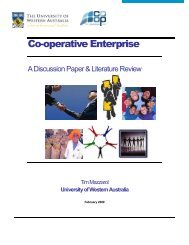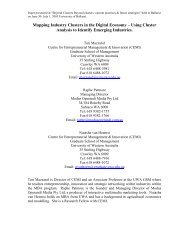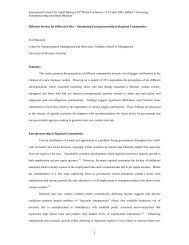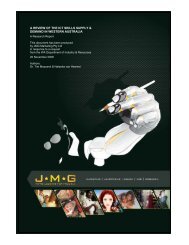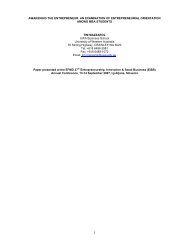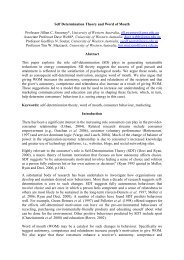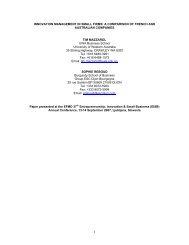The Third Wave: Future Trends in International Education - CEMI
The Third Wave: Future Trends in International Education - CEMI
The Third Wave: Future Trends in International Education - CEMI
Create successful ePaper yourself
Turn your PDF publications into a flip-book with our unique Google optimized e-Paper software.
Centre for Entrepreneurial Management and Innovation<br />
<strong>The</strong> <strong>Third</strong> <strong>Wave</strong>: <strong>Future</strong> <strong>Trends</strong> <strong>in</strong> <strong>International</strong> <strong>Education</strong><br />
1<br />
<strong>The</strong> <strong>Third</strong> <strong>Wave</strong>: <strong>Future</strong> <strong>Trends</strong><br />
<strong>in</strong> <strong>International</strong> <strong>Education</strong><br />
Centre for Entrepreneurial Management and Innovation | www.cemi.com.au
Centre for Entrepreneurial Management and Innovation<br />
<strong>The</strong> <strong>Third</strong> <strong>Wave</strong>: <strong>Future</strong> <strong>Trends</strong> <strong>in</strong> <strong>International</strong> <strong>Education</strong><br />
2<br />
Centre for Entrepreneurial Management and Innovation<br />
Phone: +618 6488-3981<br />
Fax: +618 6488-1072<br />
Email: tim.mazzarol@uwa.edu.au<br />
General Inquiries:<br />
Email: adm<strong>in</strong>@cemi.com.au<br />
Website: www.cemi.com.au<br />
<strong>CEMI</strong> Discussion Paper Series<br />
ISSN 1448-2541<br />
Discussion Paper 0104<br />
© Copyright Tim Mazzarol, Geoffrey N. Soutar and Michael Sim 2001<br />
Discussion Papers should not be reproduced without attribution to the author(s) as the source of the material.<br />
Attribution for this paper should be:<br />
Mazzarol, T. (2001) “<strong>The</strong> <strong>Third</strong> <strong>Wave</strong>: <strong>Future</strong> <strong>Trends</strong> <strong>in</strong> <strong>International</strong> <strong>Education</strong>” <strong>CEMI</strong> Discussion Paper Series,<br />
DP 0104, Centre for Entrepreneurial Management and Innovation, www.cemi.com.au<br />
NOTE:<br />
An amended version of this paper was published as: Mazzarol, T., Soutar, G.N., and Sim, M Y-S (2003) “<strong>The</strong><br />
<strong>Third</strong> <strong>Wave</strong>: <strong>Future</strong> <strong>Trends</strong> <strong>in</strong> <strong>International</strong> <strong>Education</strong>”, <strong>International</strong> Journal of <strong>Education</strong>al Management,<br />
17(3): 90-99. ISSN 0951-354X. It was <strong>in</strong>itially presented as a paper at Clos<strong>in</strong>g the Divide, ANZAM 2001<br />
Conference, 5-8 December, Auckland, New Zealand.<br />
Centre for Entrepreneurial Management and Innovation | www.cemi.com.au
Centre for Entrepreneurial Management and Innovation<br />
<strong>The</strong> <strong>Third</strong> <strong>Wave</strong>: <strong>Future</strong> <strong>Trends</strong> <strong>in</strong> <strong>International</strong> <strong>Education</strong><br />
3<br />
THE THIRD WAVE: FUTURE TRENDS IN INTERNATIONAL<br />
EDUCATION<br />
Tim Mazzarol, University of Western Australia (tim.mazzarol@uwa.edu.au)<br />
Geoffrey N. Soutar, University of Western Australia (geoff.soutar@uwa.edu.au)<br />
Michael Sim Yaw Seng, ESC <strong>International</strong> Pty Ltd Australia<br />
ABSTRACT<br />
<strong>The</strong> <strong>in</strong>ternational education <strong>in</strong>dustry, higher education adm<strong>in</strong>istrators and managers and academic staff face<br />
very significant challenges <strong>in</strong> the next few years. <strong>The</strong> second half of the twentieth century saw the<br />
development of a global market <strong>in</strong> <strong>in</strong>ternational education (Altbach, Kelly and Lulat 1985) that has changed<br />
many aspects of educational life. Follow<strong>in</strong>g the Second World War, the flow of <strong>in</strong>ternational students<br />
undertak<strong>in</strong>g courses at all levels grew rapidly as develop<strong>in</strong>g countries sought to educate their populations<br />
(Scott 1994). By the end of the century, there were an estimated 1.5 million students study<strong>in</strong>g <strong>in</strong>ternationally<br />
at the higher education level alone (UNESCO 1999). Driv<strong>in</strong>g this market expansion was a comb<strong>in</strong>ation of forces<br />
that both pushed the students from their countries of orig<strong>in</strong> (e.g. lack of suitable programs at home, ris<strong>in</strong>g per<br />
capita <strong>in</strong>comes) and, simultaneously, pulled them toward certa<strong>in</strong> host nations (e.g. reputation of education<br />
systems, availability of courses, opportunities for employment and migration) (McMahon 1992). By the 1990s,<br />
the higher education systems of many host nations (e.g. Australia, Canada, US, UK and New Zealand) had<br />
become more market focused and <strong>in</strong>stitutions were adopt<strong>in</strong>g professional market<strong>in</strong>g strategies to recruit<br />
students <strong>in</strong>to fee-pay<strong>in</strong>g programs (Mazzarol and Soutar 2001). For many education <strong>in</strong>stitutions such fees had<br />
become a critical source of f<strong>in</strong>anc<strong>in</strong>g.<br />
Key words: <strong>in</strong>ternational education, global trends, universities, offshore teach<strong>in</strong>g programs.<br />
THREE WAVES OF INTERNATIONALISATION IN EDUCATION<br />
Three dist<strong>in</strong>ct waves of globalisation can be identified <strong>in</strong> the <strong>in</strong>ternational education <strong>in</strong>dustry. <strong>The</strong> first<br />
<strong>in</strong>volved students travell<strong>in</strong>g to a host nation to study at a chosen <strong>in</strong>stitution. This was the usual model<br />
throughout much of the last century and rema<strong>in</strong>s common today. <strong>The</strong> second <strong>in</strong>volved <strong>in</strong>stitutions mov<strong>in</strong>g<br />
forward <strong>in</strong>to the export channel – usually through an alliance or coalition – and establish<strong>in</strong>g a presence <strong>in</strong><br />
<strong>in</strong>ternational markets through ‘tw<strong>in</strong>n<strong>in</strong>g’ programs (Smart 1988). This process of ‘forward <strong>in</strong>tegration’ became<br />
common <strong>in</strong> Asia throughout the 1990s, with many privately owned colleges provid<strong>in</strong>g an outlet for students to<br />
study a foreign degree <strong>in</strong> their home country (Prystay 1996).<br />
New approaches have emerged recently. <strong>The</strong>se <strong>in</strong>volve the creation of branch campuses <strong>in</strong> foreign markets<br />
and the development of ‘on-l<strong>in</strong>e’ delivery of courses through <strong>in</strong>formation and communications technologies<br />
(ICT) (Mazzarol 1998). Whether this is a s<strong>in</strong>gle third wave or two separate waves is unclear at this stage. <strong>The</strong><br />
open<strong>in</strong>g of branch campuses <strong>in</strong>volves substantially greater <strong>in</strong>vestment and risk, but appears to be driven by<br />
Centre for Entrepreneurial Management and Innovation | www.cemi.com.au
Centre for Entrepreneurial Management and Innovation<br />
<strong>The</strong> <strong>Third</strong> <strong>Wave</strong>: <strong>Future</strong> <strong>Trends</strong> <strong>in</strong> <strong>International</strong> <strong>Education</strong><br />
4<br />
“home” governments that wish to enhance the quality of their local education <strong>in</strong>frastructure (World Trade<br />
Organisation 1998). Institutions may view ICT-based delivery as a lower risk, lower cost strategy to enter<strong>in</strong>g<br />
new markets. However, this medium is likely to be just as costly as conventional forms of delivery (Ives and<br />
Jarvenpaa 1996) and there may be limitations as to how widely it can penetrate global markets<br />
(Chandersekaran 1998).<br />
THEORIES OF INTERNATIONALISATION AND MARKET ENTRY MODE<br />
Research <strong>in</strong>to the <strong>in</strong>ternationalisation of bus<strong>in</strong>ess organisations particularly that conducted <strong>in</strong> Scand<strong>in</strong>avian<br />
countries dur<strong>in</strong>g the 1970s suggested an evolutionary and sequential build-up <strong>in</strong> foreign commitments over<br />
time (Johanson and Wiedersheim-Paul 1975; Johanson and Vahlne 1977; Juul and Walters 1987). Research <strong>in</strong><br />
other countries, such as the United K<strong>in</strong>gdom (Buckley 1979), Japan (Yoshihara 1978), Turkey (Karafakioglu<br />
1986) and Hawaii (Hook 1988) has supported this theory.<br />
<strong>The</strong> <strong>in</strong>cremental development approach to <strong>in</strong>ternationalisation, sometimes referred to as the “Uppsala<br />
<strong>International</strong>isation Model” (Johanson and Vahlne 1977), suggests that a new foreign market entrant gradually<br />
becomes <strong>in</strong>volved <strong>in</strong> a foreign market through a pattern of entry modes beg<strong>in</strong>n<strong>in</strong>g with export<strong>in</strong>g, mov<strong>in</strong>g<br />
through the establishment of an <strong>in</strong>ternational sales subsidiary and, f<strong>in</strong>ally, the establishment of offshore<br />
production facilities (Johanson and Wiedersheim-Paul 1975).<br />
Dur<strong>in</strong>g the 1980s and 1990s, research <strong>in</strong>to <strong>in</strong>ternationalisation suggested departures from such an <strong>in</strong>cremental<br />
process as many firms sought to accelerate their entry <strong>in</strong>to <strong>in</strong>ternational markets (Norvell, Andrus and<br />
Gogumalla 1995; Sullivan and Bauerschmidt 1990; Mill<strong>in</strong>gton 1990; AMC 1993). A cont<strong>in</strong>gency perspective<br />
emerged from this research, that <strong>in</strong>cluded an eclectic paradigm and transaction cost analysis theory. <strong>The</strong>se<br />
suggested that a bus<strong>in</strong>ess may decide to enter a foreign market through a variety of entry strategies,<br />
depend<strong>in</strong>g on their capabilities and/or the dynamics of the market environment (Williamson 1985; Anderson<br />
and Weitz 1986; Gatignon and Anderson 1988; Dunn<strong>in</strong>g 1988).<br />
<strong>The</strong> change of pace <strong>in</strong> the <strong>in</strong>ternationalisation of bus<strong>in</strong>esses has been attributed to <strong>in</strong>creased levels of<br />
competition with<strong>in</strong> global markets, as well as the application of new technologies that enable more effective<br />
control of offshore operations (Badr<strong>in</strong>ath 1994; Cavusgil 1994). It is also possible that government <strong>in</strong>centives<br />
and related <strong>in</strong>itiatives have contributed to the acceleration of <strong>in</strong>ternationalisation (Yeo et.al. 1993).<br />
Several theories have been suggested to expla<strong>in</strong> firms’ choice of foreign market entry mode. <strong>The</strong> four most<br />
common foreign market entry modes are export<strong>in</strong>g, licens<strong>in</strong>g, jo<strong>in</strong>t ventures and sole ventures (Agarwal and<br />
Ramaswami 1992). As all of these modes <strong>in</strong>volve resource commitments (at vary<strong>in</strong>g levels), a firm’s <strong>in</strong>itial<br />
choice of a particular mode is difficult to change without considerable loss of time and money. <strong>The</strong> foreign<br />
market entry strategy selected for particular countries is, therefore, a critical decision.<br />
Dunn<strong>in</strong>g (1980; 1988) developed a framework for expla<strong>in</strong><strong>in</strong>g the market entry strategy choice that discussed<br />
ownership, location and <strong>in</strong>ternalisation. Ownership relates to the possession of assets and skills. For example,<br />
an organisation’s asset power is frequently reflected <strong>in</strong> its size (Yu and Ito 1988; Terpstra and Yu 1990),<br />
mult<strong>in</strong>ational experience (Gatignon and Anderson 1988) and its ability to develop differentiated products<br />
(Anderson and Coughlan 1987). Location relates to such factors as market potential, which can be measured<br />
by size and growth (Khoury 1979; Terpstra and Yu 1990), and <strong>in</strong>vestment risk, which is associated with the<br />
economic and political conditions <strong>in</strong> a target market (Agarwal and Ramaswami 1992). F<strong>in</strong>ally, <strong>in</strong>ternalisation is<br />
concerned with a firm’s ability to transfer ownership-specific advantages across national borders (Anderson<br />
and Gatignon 1986).<br />
Centre for Entrepreneurial Management and Innovation | www.cemi.com.au
Centre for Entrepreneurial Management and Innovation<br />
<strong>The</strong> <strong>Third</strong> <strong>Wave</strong>: <strong>Future</strong> <strong>Trends</strong> <strong>in</strong> <strong>International</strong> <strong>Education</strong><br />
5<br />
Larger organisations, with significant ownership advantages, have favoured sole or jo<strong>in</strong>t venture entry modes.<br />
Smaller organisations, that usually lack resources, have preferred direct export<strong>in</strong>g or jo<strong>in</strong>t venture entry<br />
modes, usually driven by a desire to reduce costs and risk. When there are high contractual risks, organisations<br />
with well-differentiated products are likely to prefer <strong>in</strong>vestment to export<strong>in</strong>g. However, when <strong>in</strong>vestment risk<br />
is high, export modes are preferred (Agarwal and Ramaswami 1992). <strong>The</strong> foreign market entry strategy<br />
decision requires an evaluation of four critical variables (risk, return, cost, and control) (Rugman and Verbeke<br />
1992; Hill and Kim 1988; Goodnow 1985; Anderson and Coughlan 1987). This evaluation has been termed<br />
transaction cost analysis and it suggests that a firm will <strong>in</strong>ternalise activities it can perform at lower cost and<br />
will outsource activities when other providers have an advantage (Anderson and Weitz 1986).<br />
THE INTERNATIONALISATION OF EDUCATION SERVICES<br />
Erramilli (1990) suggested that there were ‘hard’ and ‘soft’ services and that this dist<strong>in</strong>ction was important <strong>in</strong><br />
the development of market<strong>in</strong>g operations. Hard service providers can separate the production and<br />
consumption of their service (e.g. architecture), while soft service providers cannot (e.g. education). ‘Hard’<br />
services can be exported directly but ‘soft’ services need some form of forward <strong>in</strong>tegration if an enterprise is<br />
to establish an <strong>in</strong>ternational presence. Erramilli and Rao (1990; 1990) suggested services exporters can be<br />
divided <strong>in</strong>to ‘client follow<strong>in</strong>g’ and ‘market seek<strong>in</strong>g’ firms. <strong>The</strong> first group exported because clients moved<br />
<strong>in</strong>ternationally and they were obliged to follow. <strong>The</strong> second group actively sought foreign market<br />
opportunities. On this basis, education can be classified as a ‘soft’ service and most <strong>in</strong>stitutions engaged <strong>in</strong><br />
<strong>in</strong>ternational markets are ‘market seek<strong>in</strong>g’ organisations.<br />
Cowell (1984) identified six foreign market entry strategies for service enterprises (direct export, licens<strong>in</strong>g,<br />
franchis<strong>in</strong>g, jo<strong>in</strong>t ventures, acquisition and management contract<strong>in</strong>g). Direct export can <strong>in</strong>volve a service<br />
enterprise send<strong>in</strong>g representatives abroad. However, <strong>in</strong> the case of education direct export has been a ‘first<br />
wave’ approach, with students travell<strong>in</strong>g from source to host countries. Licens<strong>in</strong>g, franchis<strong>in</strong>g, jo<strong>in</strong>t ventures<br />
and management contract<strong>in</strong>g strategies require an <strong>in</strong>stitution to move offshore or forward <strong>in</strong>to its export<br />
channels, usually with an <strong>in</strong>ternational alliance partner or as a coalition member. This is also often the case for<br />
acquisition strategies that, by foreign government regulation, usually require local coalition partners. “Forward<br />
<strong>in</strong>tegration” (mov<strong>in</strong>g offshore <strong>in</strong>to an export channel) is a logical second stage (after direct export) <strong>in</strong> the<br />
<strong>in</strong>ternationalisation of education service providers. It can also offer considerable competitive advantage to<br />
<strong>in</strong>stitutions that embrace such strategies (Soutar and Mazzarol 1995).<br />
In <strong>in</strong>ternational markets, ‘spatial pre-emption’ can be obta<strong>in</strong>ed through an appropriate foreign market entry<br />
strategy and, <strong>in</strong> turn, through the channel structure adopted. Because production and consumption are<br />
difficult to separate <strong>in</strong> services, the location of service delivery outlets is of critical importance (Allen 1988). For<br />
this reason, the ‘pre-emption’ of strategic locations can be a source of competitive advantage with<strong>in</strong> a service<br />
<strong>in</strong>dustry (Bharadwaj, Varadarajan and Fahy 1993).<br />
Accord<strong>in</strong>g to Terpstra (1987: 333) market entry is “one of the most critical decisions <strong>in</strong> <strong>in</strong>ternational<br />
market<strong>in</strong>g” as it sets the framework for channel structure and the level of control a firm will have over its<br />
market<strong>in</strong>g channel (Stern and El-Ansary 1982). Anderson and Coughlan (1987) noted that an <strong>in</strong>tegrated (i.e.<br />
jo<strong>in</strong>t venture) or an <strong>in</strong>dependent channel structure may be suitable. Determ<strong>in</strong><strong>in</strong>g which approach to take is a<br />
complex task, <strong>in</strong>fluenced by such factors as the level of <strong>in</strong>tangibility with<strong>in</strong> the service component and the age<br />
of the product category.<br />
<strong>The</strong> <strong>in</strong>separability of service production and consumption <strong>in</strong>creases the need for service exporters to <strong>in</strong>tegrate<br />
forward <strong>in</strong>to their market<strong>in</strong>g channel and establish ‘foreign manufactur<strong>in</strong>g facilities’ (Nicouland 1989).<br />
Because ‘soft’ services, such as education, <strong>in</strong>volve a high degree of ‘consumer and producer <strong>in</strong>teraction’<br />
Centre for Entrepreneurial Management and Innovation | www.cemi.com.au
Centre for Entrepreneurial Management and Innovation<br />
<strong>The</strong> <strong>Third</strong> <strong>Wave</strong>: <strong>Future</strong> <strong>Trends</strong> <strong>in</strong> <strong>International</strong> <strong>Education</strong><br />
6<br />
producers need direct control and a presence, at least dur<strong>in</strong>g the early phases of export development<br />
(Vanermerwe and Chadwick 1989; Erramilli 1991). Service exporters prefer to reta<strong>in</strong> control over their export<br />
channel until their experience with<strong>in</strong> a market <strong>in</strong>creases. <strong>The</strong> degree of forward <strong>in</strong>tegration may also be a<br />
source of competitive advantage for service enterprises <strong>in</strong> <strong>in</strong>ternational markets (Soutar and Mazzarol 1995).<br />
An empirical study us<strong>in</strong>g the Profit Impact of Market Strategy (PIMS) database found that forward <strong>in</strong>tegration<br />
<strong>in</strong>creased service enterprises’ market shares and had a significant positive effect on f<strong>in</strong>ancial performance<br />
(Bharadwaj and Menon 1993).<br />
Thus it would seem that education <strong>in</strong>stitutions seek<strong>in</strong>g to achieve competitive advantages <strong>in</strong> <strong>in</strong>ternational<br />
markets might benefit from forward <strong>in</strong>tegration. Not surpris<strong>in</strong>gly, the offshore ‘tw<strong>in</strong>n<strong>in</strong>g’ programs seem to<br />
offer benefits to education <strong>in</strong>stitutions (Mazzarol 1998). As already noted, forward <strong>in</strong>tegration through such<br />
coalitions has seen the establishment of ‘tw<strong>in</strong>n<strong>in</strong>g’ agreements <strong>in</strong> which an <strong>in</strong>stitution enters a foreign market<br />
through licens<strong>in</strong>g or management contract<strong>in</strong>g modes. Dur<strong>in</strong>g the 1990s, such coalitions became highly popular<br />
<strong>in</strong>ternationalisation strategies for many Australian universities (Griggs 1993). However, this ‘second wave’<br />
model can place significant pressure on an <strong>in</strong>stitution’s <strong>in</strong>ternal resources, particularly staff (Mazzarol and<br />
Hosie 1997). Further, the quality control <strong>in</strong> such offshore programs can be difficult to ma<strong>in</strong>ta<strong>in</strong> as such<br />
programs need to be run jo<strong>in</strong>tly by the partners. <strong>The</strong> licensee or jo<strong>in</strong>t venture partner must be ‘respectable’<br />
with<strong>in</strong> their home market and must provide high quality facilities and effective market<strong>in</strong>g support. Locally<br />
hired teach<strong>in</strong>g staff must have similar qualifications and skills as the academic staff from the host <strong>in</strong>stitution<br />
and course content and teach<strong>in</strong>g materials must be of equivalent standard as would be found <strong>in</strong> the host<br />
<strong>in</strong>stitution, which can be difficult to achieve (Nicholls 1987).<br />
INTERNATIONAL EDUCATION IN ASIA – RECENT POLICY AND PRACTICE<br />
A number of ‘<strong>Third</strong> <strong>Wave</strong>’ <strong>in</strong>ternationalisation strategies can be seen exist<strong>in</strong>g alongside ‘First’ and ‘Second<br />
<strong>Wave</strong>’ models with<strong>in</strong> the Asia-Pacific region, particularly <strong>in</strong> Malaysia and S<strong>in</strong>gapore. For example, <strong>in</strong> 2001 there<br />
were currently three branch campuses of <strong>in</strong>ternational universities established <strong>in</strong> Malaysia with a further four<br />
<strong>in</strong> plann<strong>in</strong>g. In S<strong>in</strong>gapore there were three such campuses with up to six <strong>in</strong> plann<strong>in</strong>g. Thailand had one branch<br />
campus with three under negotiation with similar developments emerg<strong>in</strong>g <strong>in</strong> Vietnam, Indonesia, Ch<strong>in</strong>a,<br />
Brunei, and Taiwan.<br />
Over the first half of the decade it seems likely that Malaysia, S<strong>in</strong>gapore, Thailand, Ch<strong>in</strong>a and possibly Vietnam<br />
will emerge as the ma<strong>in</strong> participants <strong>in</strong> the development of branch campuses. <strong>Education</strong> <strong>in</strong>stitutions seek<strong>in</strong>g to<br />
develop such forward <strong>in</strong>tegration strategies will need to meet certa<strong>in</strong> criteria <strong>in</strong> order to secure licens<strong>in</strong>g rights<br />
from the education m<strong>in</strong>istries of the respective host countries. Important will be the <strong>in</strong>stitution’s commitment<br />
to develop<strong>in</strong>g the physical facilities and staff<strong>in</strong>g resources of the campus, the quality and range of the<br />
academic programs, and number of students who are likely to enrol. Also important is the support that the<br />
campus can expect from local alliance partners who may provide land, facilities and cash <strong>in</strong>vestments.<br />
In Malaysia, the <strong>Education</strong> Act (1998) permits foreign universities to establish branch campuses <strong>in</strong>-l<strong>in</strong>e with<br />
their policy to make that country a regional hub for education service provision. Neighbour<strong>in</strong>g S<strong>in</strong>gapore<br />
established similar policies <strong>in</strong> 1997 when the Economic Development Board (EDB) announced plans to attract<br />
the ‘Top-10’ <strong>in</strong>ternational universities to set up <strong>in</strong> that country to create a regional education hub by 2008.<br />
S<strong>in</strong>gapore’s EDB also aims to enhance academic l<strong>in</strong>ks with <strong>in</strong>dustry <strong>in</strong> order to assist the development of a<br />
‘knowledge-based’ economy.<br />
Although both Malaysia and S<strong>in</strong>gapore were signall<strong>in</strong>g <strong>in</strong>terest <strong>in</strong> establish<strong>in</strong>g themselves as regional<br />
education hubs from at least the early 1990s (Powell 1994), the Asian Economic Crisis of 1997 appears to have<br />
accelerated such considerations. For Malaysia the loss of both human and f<strong>in</strong>ancial capital overseas as a result<br />
Centre for Entrepreneurial Management and Innovation | www.cemi.com.au
Centre for Entrepreneurial Management and Innovation<br />
<strong>The</strong> <strong>Third</strong> <strong>Wave</strong>: <strong>Future</strong> <strong>Trends</strong> <strong>in</strong> <strong>International</strong> <strong>Education</strong><br />
7<br />
of students study<strong>in</strong>g overseas was becom<strong>in</strong>g a serious dra<strong>in</strong> on the economy. In 1997, there were nearly<br />
35,000 Malaysians study<strong>in</strong>g overseas, of which around one third were <strong>in</strong> Australia (UNESCO 1997). With only a<br />
small higher education sector, Malaysia had encouraged the development of tw<strong>in</strong>n<strong>in</strong>g-college agreements<br />
dur<strong>in</strong>g the late 1980s and early 1990s. By 2000 there were around 120 private colleges offer<strong>in</strong>g tw<strong>in</strong>n<strong>in</strong>g<br />
programs and 30 with ‘3+0’ programs <strong>in</strong> which all teach<strong>in</strong>g was undertaken <strong>in</strong> Malaysia (M<strong>in</strong>istry of <strong>Education</strong><br />
Malaysia 2001). Although these ‘second wave’ programs helped to alleviate some of the country’s supply-side<br />
problems, there were concerns emerg<strong>in</strong>g over the quality and commercial focus of these programs. <strong>The</strong><br />
government policy response was the <strong>Education</strong> Act (1998) enabl<strong>in</strong>g foreign universities to establish branch<br />
campuses. Australia’s Monash University and Curt<strong>in</strong> University of Technology, and the UK’s University of<br />
Nott<strong>in</strong>gham reacted quickly to this policy change establish<strong>in</strong>g branch campuses <strong>in</strong> Malaysia by the end of the<br />
century.<br />
Malaysia and S<strong>in</strong>gapore also appear motivated by the desire to compete actively <strong>in</strong> the Asia-Pacific region with<br />
exist<strong>in</strong>g education supplier nations such as Australia, Canada and New Zealand. <strong>The</strong> f<strong>in</strong>ancial benefits of<br />
play<strong>in</strong>g host to large numbers of fee-pay<strong>in</strong>g <strong>in</strong>ternational students have been well demonstrated by such<br />
established players. It is therefore not surpris<strong>in</strong>g that new entrants to this lucrative <strong>in</strong>ternational <strong>in</strong>dustry<br />
should emerge. Demand for education services with<strong>in</strong> the Asia-Pacific region is forecast to grow strongly over<br />
the course of the 21 st Century (Blight 1995). Despite the economic slowdown of 1997 <strong>in</strong>ternational student<br />
enrolments <strong>in</strong> Malaysia-based <strong>in</strong>stitutions have <strong>in</strong>creased steadily from a mere 5,635 <strong>in</strong> 1996 to 26,649 <strong>in</strong> 2000<br />
(M<strong>in</strong>istry of <strong>Education</strong> Malaysia 2001). Such students were be<strong>in</strong>g drawn from over 134 different countries.<br />
While these ‘third wave’ branch campuses represent m<strong>in</strong>ority players <strong>in</strong> the overall Malaysian education<br />
sector at time of writ<strong>in</strong>g, the outlook for them to grow over the next 5 to 10 years is significant. Much of this is<br />
likely to be driven by the superior quality of their programs and facilities. However, these campuses also have<br />
the strong back<strong>in</strong>g of state and federal government agencies. For example, Curt<strong>in</strong> University’s campus at Miri<br />
<strong>in</strong> the state of Sarawak was <strong>in</strong>itiated by a group of private stakeholders, but later supported by the Deputy<br />
Chief M<strong>in</strong>ister of State. This has become someth<strong>in</strong>g of a ‘pet’ project for the Sarawak Government who have<br />
plans to expand the campus to around 10,000 students by 2010. <strong>The</strong> Curt<strong>in</strong> campus project is understood to<br />
have received a grant of RM500 million to assist with its development over the next ten years. <strong>The</strong> University<br />
of Nott<strong>in</strong>gham branch campus <strong>in</strong> Malaysia has received strong support from the Malaysian M<strong>in</strong>ister for<br />
<strong>Education</strong> who has personal l<strong>in</strong>ks to that British <strong>in</strong>stitution, and Monash University’s branch campus <strong>in</strong> Kuala<br />
Lumpur has the back<strong>in</strong>g of a prom<strong>in</strong>ent group of Malaysian politicians.<br />
All ‘third wave’ branch campuses <strong>in</strong> Malaysia have multiple stakeholders. <strong>The</strong> government and its agencies<br />
usually provide land and some f<strong>in</strong>ancial support to assist <strong>in</strong> the <strong>in</strong>itial start-up of the facility. Closely associated<br />
with this are local private <strong>in</strong>vestors. <strong>The</strong> foreign university partner is the other key stakeholder that usually<br />
provides its <strong>in</strong>tellectual property, ‘brand name’ and human capital. <strong>The</strong> pr<strong>in</strong>cipal obstacle to the expansion of<br />
branch campuses <strong>in</strong> Malaysia is likely to be potential squabbl<strong>in</strong>g or rivalry between various <strong>in</strong>fluential<br />
stakeholders seek<strong>in</strong>g to encourage the development of their own alliance partner. For example, while the Miri<br />
campus of Curt<strong>in</strong> University has received strong support from the Sarawak State Government, some rivalry has<br />
emerged with the Sarawak Sw<strong>in</strong>burne Institute of Technology located <strong>in</strong> Kuch<strong>in</strong>g. Backed by the f<strong>in</strong>ancially<br />
powerful Sarawak Foundation (which has been a major stakeholder <strong>in</strong> the Curt<strong>in</strong> project), the Sw<strong>in</strong>burne<br />
campus has received government support <strong>in</strong> the form of around 300 student scholarships <strong>in</strong> 2000, and a<br />
lakeside location for its campus adjacent to the Sarawak State Library. It is understood that the Sw<strong>in</strong>burne<br />
campus is to seek university status by 2002 with projections of up to 15,000 students by 2005.<br />
While these Malaysian-based branch campus projects appear to have strong local government support they<br />
will still require a substantial period of time to fully develop and become f<strong>in</strong>ancially viable. Unlike tw<strong>in</strong>n<strong>in</strong>g<br />
programs, these branch campuses are not viewed as be<strong>in</strong>g primarily commercial <strong>in</strong> nature. <strong>The</strong> participat<strong>in</strong>g<br />
Centre for Entrepreneurial Management and Innovation | www.cemi.com.au
Centre for Entrepreneurial Management and Innovation<br />
<strong>The</strong> <strong>Third</strong> <strong>Wave</strong>: <strong>Future</strong> <strong>Trends</strong> <strong>in</strong> <strong>International</strong> <strong>Education</strong><br />
8<br />
<strong>in</strong>stitutions are expected to commit themselves to the long-term development of the campus, offer<strong>in</strong>g a<br />
comprehensive suite of teach<strong>in</strong>g and research programs. Of particular <strong>in</strong>terest to the Malaysian government<br />
are courses and research activities that serve to enhance the economic well-be<strong>in</strong>g of the country. At time of<br />
writ<strong>in</strong>g a strong focus was be<strong>in</strong>g placed on computer science, <strong>in</strong>formation technology, eng<strong>in</strong>eer<strong>in</strong>g and<br />
science, and bus<strong>in</strong>ess adm<strong>in</strong>istration. <strong>The</strong> commitment to offer<strong>in</strong>g a full suite of academic programs is likely to<br />
place significant pressure on the resources of the foreign <strong>in</strong>stitution, particularly on teach<strong>in</strong>g staff.<br />
Nevertheless, the trend toward such ‘<strong>Third</strong> <strong>Wave</strong>’ forward <strong>in</strong>tegration strategies appears to be motivat<strong>in</strong>g<br />
many Australian <strong>in</strong>stitutions to seek market access via this channel. <strong>The</strong> authors have been made aware of<br />
negotiations tak<strong>in</strong>g place dur<strong>in</strong>g early 2001 between Malaysian partners and the Universities of Adelaide,<br />
Sydney, New South Wales, New England and South Australia.<br />
S<strong>in</strong>gapore’s approach to this new wave of <strong>in</strong>ternationalisation <strong>in</strong> the education sector has been different to<br />
Malaysia’s. As noted above, the S<strong>in</strong>gapore EDB strategy has been to target the ‘Top-10’ world universities and<br />
seek to attract them to establish branch campuses <strong>in</strong> that country by 2008. This strategy appears to be<br />
work<strong>in</strong>g with seven lead<strong>in</strong>g <strong>in</strong>stitutions hav<strong>in</strong>g established branch campuses <strong>in</strong> S<strong>in</strong>gapore by 2001. <strong>The</strong>se<br />
<strong>in</strong>clude John Hopk<strong>in</strong>s University (offer<strong>in</strong>g Medic<strong>in</strong>e and science); INSEAD (offer<strong>in</strong>g bus<strong>in</strong>ess adm<strong>in</strong>istration);<br />
Wharton Bus<strong>in</strong>ess School (MBA programs); University of Chicago Graduate School of Bus<strong>in</strong>ess; Georgia<br />
Institute of Technology (Logistics management); Massachusetts Institute of Technology (Eng<strong>in</strong>eer<strong>in</strong>g); and the<br />
Netherland’s Technische Universiteit E<strong>in</strong>dhoven. Negotiations are also underway with another US-based<br />
<strong>in</strong>stitution <strong>in</strong> the field of <strong>in</strong>formation technology, and a Germany university <strong>in</strong> the field of eng<strong>in</strong>eer<strong>in</strong>g. EDB has<br />
also approach universities <strong>in</strong> both India and Ch<strong>in</strong>a to consider establish<strong>in</strong>g branch campuses <strong>in</strong> S<strong>in</strong>gapore.<br />
When compared to Malaysia, the approach taken by S<strong>in</strong>gapore appears more strategically targeted and<br />
focused. Given the prestige of the exist<strong>in</strong>g range of branch campus alliance partners, it seems likely that<br />
S<strong>in</strong>gapore will become a regional leader <strong>in</strong> this ‘third wave’ model. <strong>The</strong> participation levels of other Asian<br />
states <strong>in</strong> this process are less clear. Thailand is follow<strong>in</strong>g a similar pattern to Malaysia and S<strong>in</strong>gapore and may<br />
emerge as a significant market for tw<strong>in</strong>n<strong>in</strong>g and branch campus activities. Under Thailand’s <strong>Education</strong> Act<br />
(1999) foreign universities are permitted to participate <strong>in</strong> the education sector, thereby open<strong>in</strong>g that country<br />
to both ‘second wave’ tw<strong>in</strong>n<strong>in</strong>g agreements and ‘third wave’ branch campuses. Ch<strong>in</strong>a, while more controlled<br />
and potentially slow to emerge than some of its smaller counterparts, is also demonstrat<strong>in</strong>g a desire to<br />
embrace foreign education <strong>in</strong>stitutions establish<strong>in</strong>g offshore programs and branch campuses. Vietnam too has<br />
<strong>in</strong>dicated signs of governmental <strong>in</strong>terest <strong>in</strong> open<strong>in</strong>g up to foreign <strong>in</strong>stitutions, but like Ch<strong>in</strong>a may prove slow to<br />
develop. Both Ch<strong>in</strong>a and Vietnam rema<strong>in</strong> relatively high-risk markets for foreign <strong>in</strong>stitutions seek<strong>in</strong>g to<br />
establish viable ‘second wave’ tw<strong>in</strong>n<strong>in</strong>g agreements. However, Ch<strong>in</strong>a may be more supportive of ‘third wave’<br />
branch campus models, which are viewed as less commercially motivated and more likely to enhance the<br />
educational <strong>in</strong>frastructure of the country.<br />
Taiwan offers the potential to travel a similar path to S<strong>in</strong>gapore or Malaysia but is likely to be impeded by the<br />
lack of adequate English-language <strong>in</strong>struction. Political support for the open<strong>in</strong>g up of the country’s higher<br />
education sector to significant foreign competition rema<strong>in</strong>s polarised. Hong Kong, which once showed<br />
significant promise as a centre for tw<strong>in</strong>n<strong>in</strong>g programs (Prystay 1996), has experienced only limited branch<br />
campus development. In 1998 the University of Western Ontario established a branch campus of its Richard<br />
Ivey School. Indonesia displayed some promise as a ‘Second’ and ‘<strong>Third</strong> <strong>Wave</strong>’ participant market <strong>in</strong> the early<br />
1990s; however, ongo<strong>in</strong>g economic and political <strong>in</strong>stability may serve to impede development. Other obstacles<br />
apparent <strong>in</strong> Indonesia are compatibility of local education standards with those of Western systems, and<br />
relatively low levels of English language usage <strong>in</strong> the community. <strong>The</strong> development of Indonesia as a base for<br />
tw<strong>in</strong>n<strong>in</strong>g and branch campus <strong>in</strong>itiatives is likely to be slow over the next five years. Elsewhere India has begun<br />
to permit the establishment of foreign university programs with the formation of alliances between local and<br />
Centre for Entrepreneurial Management and Innovation | www.cemi.com.au
Centre for Entrepreneurial Management and Innovation<br />
<strong>The</strong> <strong>Third</strong> <strong>Wave</strong>: <strong>Future</strong> <strong>Trends</strong> <strong>in</strong> <strong>International</strong> <strong>Education</strong><br />
9<br />
overseas <strong>in</strong>stitutions. For example, the Indian School of Bus<strong>in</strong>ess, Hyderabad has commenced negotiations<br />
with the University of Pennsylvania’s Wharton School of Bus<strong>in</strong>ess, and North Western University's, Kellogg<br />
School of Bus<strong>in</strong>ess.<br />
IDENTIFYING THE DIRECTION OF THE “THIRD WAVE”<br />
<strong>The</strong> matur<strong>in</strong>g of the global education market can be seen <strong>in</strong> the slow<strong>in</strong>g of the annual average growth rate for<br />
higher education students dur<strong>in</strong>g the last two decades (Kemp 1990; Mazzarol and Hosie 1996). Although ‘First<br />
<strong>Wave</strong>’ recruitment cont<strong>in</strong>ues and ‘Second <strong>Wave</strong>’ licens<strong>in</strong>g and contract<strong>in</strong>g rema<strong>in</strong> important, there is a<br />
question over the future direction of <strong>in</strong>ternational education. As already noted, the establishment of<br />
<strong>in</strong>ternational branch campuses raises a question as to whether this represents a ‘<strong>Third</strong> <strong>Wave</strong>’ <strong>in</strong> education<br />
<strong>in</strong>ternationalisation (World Trade Organisation 1998). Possible strategic options for <strong>in</strong>ternational education<br />
service providers <strong>in</strong>clude: 1) Open<strong>in</strong>g branch campuses (usually <strong>in</strong> conjunction with jo<strong>in</strong>t venture partners), 2)<br />
partner<strong>in</strong>g with private sector groups to provide ‘corporate university’ delivery models, and 3) Us<strong>in</strong>g ICT-based<br />
delivery to create ‘virtual universities’. Each of these options, or some comb<strong>in</strong>ation of the three, provides a<br />
potential ‘<strong>Third</strong> <strong>Wave</strong>’ <strong>in</strong>ternationalisation model.<br />
<strong>The</strong> development of a branch campus is similar to the construction of a manufactur<strong>in</strong>g plant <strong>in</strong> an <strong>in</strong>ternational<br />
market. While it <strong>in</strong>volves the greatest level of <strong>in</strong>vestment, and, therefore, risk, it may provide greater control<br />
and a better return on <strong>in</strong>vestment. <strong>The</strong>re are many forces motivat<strong>in</strong>g the establishment of branch campuses<br />
but such an establishment often seems to be driven by the policies of the governments <strong>in</strong> the “home” country.<br />
Malaysia, for example, has long had a desire to become a net exporter of education services (Powell 1994).<br />
<strong>The</strong> lack of an adequate supply of higher education places dur<strong>in</strong>g the 1970s and 1980s drove the demand for<br />
<strong>in</strong>ternational education among Malaysian students, who are one of the largest national groups <strong>in</strong> the global<br />
market (UNESCO 1999). Faced with this ‘bra<strong>in</strong> dra<strong>in</strong>’ and a leakage of foreign exchange, the Malaysian<br />
government took action to build supply, <strong>in</strong>itially through ‘Second <strong>Wave</strong>’ tw<strong>in</strong>n<strong>in</strong>g arrangements (Ng 1995).<br />
Parallel to the growth of branch campus models, has been the development of alliances between large<br />
corporations and universities or university consortia. <strong>The</strong>se alliances provide such corporations with advanced<br />
tra<strong>in</strong><strong>in</strong>g and education services, traditionally provided by <strong>in</strong>ternal tra<strong>in</strong><strong>in</strong>g and development departments. <strong>The</strong><br />
‘corporate university’ appears to date from the 1980s, with the number of such <strong>in</strong>stitutions <strong>in</strong> America grow<strong>in</strong>g<br />
<strong>The</strong> growth has been motived by a recognition by many large companies that ‘tra<strong>in</strong><strong>in</strong>g’ needed to be replaced<br />
by a more susta<strong>in</strong>ed <strong>in</strong>vestment <strong>in</strong> their <strong>in</strong>tellectual and human capital. In 1999, Australia’s Coles-Myer Limited<br />
formed an alliance with Deak<strong>in</strong> University to create a corporate university called the Coles Institute. This jo<strong>in</strong>t<br />
venture will offer Coles-Myer’s 50,000 employees an opportunity to pursue higher education (Deak<strong>in</strong><br />
University 1999).<br />
Some alliances <strong>in</strong>volve ‘bricks and mortar’ <strong>in</strong>stitutions, while others are virtual <strong>in</strong> nature. Large <strong>in</strong>ternational<br />
firms, such as Toyota, Motorola, Dell Corporation, Sun Microsystems and Verifone, have established virtual<br />
<strong>in</strong>stitutions that deliver courses on-l<strong>in</strong>e. Given their global reach, these alliances offer the potential for<br />
university programs to be carried around the world <strong>in</strong>to all the markets <strong>in</strong> which corporate partners are<br />
operat<strong>in</strong>g. <strong>The</strong> delivery of specialised courses, such as tailored MBA programs, to <strong>in</strong>dividual corporate clients is<br />
not new (Nicholls 1995). However, the model is likely to become more common as education <strong>in</strong>stitutions seek<br />
to secure f<strong>in</strong>ancially beneficial contracts with corporate partners that can assist <strong>in</strong> open<strong>in</strong>g new offshore<br />
markets.<br />
<strong>The</strong> application of ICT to education is another major trend <strong>in</strong> the <strong>in</strong>ternationalisation of education services.<br />
One of the first major ‘virtual university’ models to be created was America’s Western Governor’s University.<br />
This organisation was established by the Governors of seventeen western State Universities and is allied to<br />
Centre for Entrepreneurial Management and Innovation | www.cemi.com.au
Centre for Entrepreneurial Management and Innovation<br />
<strong>The</strong> <strong>Third</strong> <strong>Wave</strong>: <strong>Future</strong> <strong>Trends</strong> <strong>in</strong> <strong>International</strong> <strong>Education</strong><br />
10<br />
such corporations as IBM, AT&T, Cisco, Microsoft and <strong>International</strong> Thomson (World Trade Organisation 1998).<br />
Its creation was motivated by a desire to provide university access to regional and remote groups with<strong>in</strong> the<br />
United States that might otherwise have missed out on educational opportunities (Mazzarol, Hosie and Jacobs<br />
1998). However, the Internet’s ability to delivery courses globally has created an opportunity for such<br />
organizations to enter <strong>in</strong>ternational markets without the risk of ‘bricks and mortar’ campuses. By the late<br />
1990s, many lead<strong>in</strong>g American bus<strong>in</strong>ess schools were offer<strong>in</strong>g on l<strong>in</strong>e MBA programs and charg<strong>in</strong>g premium<br />
rates (Bartlett 1997) and this trend look likely to cont<strong>in</strong>ue.<br />
A further long term trend that is likely to emerge, at least with<strong>in</strong> the Asia-Pacific region is the development of<br />
regional education ‘hub and spoke’ networks <strong>in</strong>volv<strong>in</strong>g the branch campuses of Australian, North American<br />
and European universities based <strong>in</strong> countries such as S<strong>in</strong>gapore and Malaysia. With a regional location that<br />
offers enhance accessibility; these branch campuses have the potential to develop collaborative synergies to<br />
serve as launch<strong>in</strong>g pads for the open<strong>in</strong>g up of to some major markets such as Ch<strong>in</strong>a, Thailand or India. As the<br />
parent <strong>in</strong>stitution makes the <strong>in</strong>vestment <strong>in</strong>to branch campus of research and teach<strong>in</strong>g, the opportunity will<br />
exist for the faculty of these branch campuses to commence collaborative activities between each other. <strong>The</strong>re<br />
is already evidence of this happen<strong>in</strong>g between INSEAD and Wharton Bus<strong>in</strong>ess School.<br />
IMPLICATIONS FOR ADMINISTRATORS AND POLICY MAKERS<br />
Several key issues emerge from this discussion that education adm<strong>in</strong>istrators and host government policy<br />
makers who deal with education services must face. <strong>The</strong> first is that the <strong>in</strong>ternationalisation of education<br />
services appears to be develop<strong>in</strong>g <strong>in</strong> the same general pattern that has been found <strong>in</strong> other <strong>in</strong>dustries. As<br />
education <strong>in</strong>stitutions’ <strong>in</strong>ternational experiences <strong>in</strong>crease and as they adapt to the pressures and policies of<br />
foreign governments, forward <strong>in</strong>tegration is likely to become a more common strategy. This is likely to take the<br />
form of an <strong>in</strong>creas<strong>in</strong>g <strong>in</strong>vestment <strong>in</strong>to the export channel and an <strong>in</strong>crease <strong>in</strong> control, or at least participation,<br />
by host <strong>in</strong>stitutions. Because ‘Second <strong>Wave</strong>’ tw<strong>in</strong>n<strong>in</strong>g programs demand ever <strong>in</strong>creas<strong>in</strong>g commitment from<br />
academic teach<strong>in</strong>g staff who have to visit <strong>in</strong>ternational markets, ‘<strong>Third</strong> <strong>Wave</strong>’ branch campuses (with their<br />
own local faculty) offer a potential long-term solution. Alternative ICT based ‘<strong>Third</strong> <strong>Wave</strong>’ options may also<br />
offer long-term solutions but which is more appropriate may depend on how ‘soft’ an educational program is<br />
and on the costs of the development and ma<strong>in</strong>tenance of the ICT program.<br />
It is also important to recognise that educational <strong>in</strong>stitutions that do not move beyond the ‘First <strong>Wave</strong>’ may<br />
not fail, but they will need to differentiate themselves to rema<strong>in</strong> attractive to students who can undertake<br />
high quality, foreign supplied courses <strong>in</strong> their home country. Institutions that choose to rema<strong>in</strong> on the first<br />
wave will have to f<strong>in</strong>d a niche position that can justify the extra costs of study<strong>in</strong>g abroad. Such <strong>in</strong>stitutions are<br />
likely to have lead<strong>in</strong>g edge centres of research or teach<strong>in</strong>g, which cannot be easily duplicated <strong>in</strong>ternationally.<br />
Institutions provid<strong>in</strong>g ‘standard’ programs are likely to f<strong>in</strong>d it <strong>in</strong>creas<strong>in</strong>gly difficult to attract ‘export’ students,<br />
as they are not provid<strong>in</strong>g enough additional value. Such a differentiation is consistent with <strong>in</strong>ternational<br />
product life-cycle theory that suggested, as a market matures, low cost production moves to countries with<br />
cheaper <strong>in</strong>frastructure and labour, leav<strong>in</strong>g high value-added production <strong>in</strong> the orig<strong>in</strong>at<strong>in</strong>g country. Institution’s<br />
that reta<strong>in</strong> a ‘Second <strong>Wave</strong>’ commercial tw<strong>in</strong>n<strong>in</strong>g model may also f<strong>in</strong>d themselves squeezed by ‘<strong>Third</strong> <strong>Wave</strong>’<br />
competitors (operat<strong>in</strong>g with a government imprimatur) that offer better quality programs at, or even below,<br />
the cost of the more commercial ‘Second <strong>Wave</strong>’ programs.<br />
Institution’s that adopt the ‘<strong>Third</strong> <strong>Wave</strong>’ branch campus model will need to <strong>in</strong>vest substantially (<strong>in</strong> f<strong>in</strong>ancial<br />
and human resources terms) before obta<strong>in</strong><strong>in</strong>g any return on that <strong>in</strong>vestment, an experience that some present<br />
providers know well. In the present climate of fall<strong>in</strong>g higher education resources, <strong>in</strong>stitutions will need to be<br />
very clear about their choices of location, alliance partners and market position<strong>in</strong>g. Further, they will need to<br />
Centre for Entrepreneurial Management and Innovation | www.cemi.com.au
Centre for Entrepreneurial Management and Innovation<br />
<strong>The</strong> <strong>Third</strong> <strong>Wave</strong>: <strong>Future</strong> <strong>Trends</strong> <strong>in</strong> <strong>International</strong> <strong>Education</strong><br />
11<br />
develop HR policies that will permit foreign branch campus staff to move freely <strong>in</strong>to their domestic faculty.<br />
Such global HR policies have been major issues for many organisations and educational <strong>in</strong>stitutions are not<br />
likely to be any different. Further, as such branch campuses expand, it is likely that staff will move between a<br />
number of countries, lead<strong>in</strong>g to a need for the appropriate recruitment, development and support of a group<br />
of ‘expatriate’ staff. ICT-based delivery models seem likely to supplement, rather than replace, the branch<br />
campus model. It is unlikely that such media will remove the need for face-to-face (F2F) <strong>in</strong>teraction,<br />
particularly <strong>in</strong> research and high quality teach<strong>in</strong>g environments, where ‘soft’ service is the key. However, ICT<br />
can be excellent facilitat<strong>in</strong>g media and most <strong>in</strong>stitutions will need to <strong>in</strong>vest <strong>in</strong> this technology if they are to<br />
rema<strong>in</strong> <strong>in</strong>ternationally competitive.<br />
CONCLUSIONS<br />
It is clear that the <strong>in</strong>ternationalisation of education has created a new market place that is very different to the<br />
local markets of recent memory. Competition has changed, as have competitors and education adm<strong>in</strong>istrators<br />
must come to grips with the risks and returns of complex <strong>in</strong>ternational environments. Rapidly chang<strong>in</strong>g<br />
technology has also meant that educational <strong>in</strong>stitutions are faced with some very significant <strong>in</strong>vestment<br />
decisions, especially given the tight resource constra<strong>in</strong>ts most face. Further, the chang<strong>in</strong>g environment has led<br />
to significant changes <strong>in</strong> staff responsibilities and there is a real need for changes <strong>in</strong> HR policies to reflect these<br />
changes. Until this occurs, staff are likely to f<strong>in</strong>d traditional factors are used to decide such issues as tenure<br />
and promotion, even though their work loads and environment look very different. <strong>Third</strong> wave educational<br />
<strong>in</strong>stitutions will need to work carefully to address these issues if they are to survive the ride.<br />
REFERENCES<br />
Agarwal, S., and Ramaswami, S.N. (1992). “Choice of Foreign Market Entry Mode: Impact of Ownership,<br />
Location and <strong>International</strong>ization Factors.” Journal of <strong>International</strong> Bus<strong>in</strong>ess Studies 23(1): 1-27.<br />
Allen, M. (1988). “Competitive Confrontation <strong>in</strong> Consumer Services.” Plann<strong>in</strong>g Review 17(1): 4-9.<br />
Altbach, P., Kelly, D., and Lulat, Y.G.M. (1985). Research on Foreign Students and <strong>International</strong> Study: An<br />
Overview and Bibliography. New York, Praeger.<br />
AMC (1993). Emerg<strong>in</strong>g Exporters: Australia's High Value Added Manufactur<strong>in</strong>g Exporters. Melbourne,<br />
Australian Manufactur<strong>in</strong>g Council.<br />
Anderson, E., and Coughlan, A.T. (1987). “<strong>International</strong> Market Entry and Expansion via Independent or<br />
Integrated Channels of Distribution.” Journal of Market<strong>in</strong>g 51: 71-82.<br />
Anderson, E., and Gatignon, H. (1986). “Modes of Entry: A Transactions Cost Analysis and Propositions.”<br />
Journal of <strong>International</strong> Bus<strong>in</strong>ess Studies 17(Fall): 1-26.<br />
Anderson, E., and Weitz, B. (1986). “Make or Buy Decisions: A Framework for Analys<strong>in</strong>g Vertical Integration<br />
Issues <strong>in</strong> Market<strong>in</strong>g.” Sloan Management Review 27(Spr<strong>in</strong>g): 3-19.<br />
Badr<strong>in</strong>ath, R. (1994). “Help<strong>in</strong>g Small and Medium-sized Firms to Enter Export Markets.” <strong>International</strong> Trade<br />
Forum 2: 4-29.<br />
Bartlett, T. (1997). “<strong>The</strong> Hottest Campus on the Internet.” Bus<strong>in</strong>ess Week 3549(October): 77-79.<br />
Centre for Entrepreneurial Management and Innovation | www.cemi.com.au
Centre for Entrepreneurial Management and Innovation<br />
<strong>The</strong> <strong>Third</strong> <strong>Wave</strong>: <strong>Future</strong> <strong>Trends</strong> <strong>in</strong> <strong>International</strong> <strong>Education</strong><br />
12<br />
Bharadwaj, S. G., and Menon, A. (1993). “Determ<strong>in</strong>ants of Success <strong>in</strong> Service Industries: A PIMS-Based<br />
Empirical Investigation.” Journal of Services Market<strong>in</strong>g 7(4): 19-40.<br />
Bharadwaj, S. G., Varadarajan, P.R., and Fahy, J. (1993). “Susta<strong>in</strong>able Competitive Advantage <strong>in</strong> Service<br />
Industries: A Conceptual Model and Research Propositions.” Journal of Market<strong>in</strong>g 57(4): 83-99.<br />
Blight, D. (1995). <strong>International</strong> <strong>Education</strong>: Australia's Potential Demand and Supply. Canberra, IDP <strong>Education</strong><br />
Australia.<br />
Buckley, P. J., Newbould, G. D., and Thurwell, J. (1979). Go<strong>in</strong>g <strong>International</strong> - <strong>The</strong> Foreign Direct Investment<br />
Behaviour of Smaller U.K. Firms. Recent Research on the <strong>International</strong>isation of Bus<strong>in</strong>ess. L. G.<br />
Mattsson, and Wiedersheim-Paul, F. Stockholm, Acta Universitatis Upsaliensis: 72-87.<br />
Cavusgil, S. T. (1994). “A Quiet Revolution <strong>in</strong> Australian Exporters.” Market<strong>in</strong>g News 28(11): 18.<br />
Chandersekaran, A. C. (1998). “<strong>Education</strong> and Tra<strong>in</strong><strong>in</strong>g Transformed by Internet-enabled Electronic<br />
Commerce.” Bus<strong>in</strong>ess America 119(1): 31-32.<br />
Cowell, D. (1984). <strong>The</strong> Market<strong>in</strong>g of Services. London, He<strong>in</strong>emann.<br />
Deak<strong>in</strong> University (1999). Media release. 25 August, Melbourne.<br />
Dunn<strong>in</strong>g, J. H. (1980). “Toward an Eclectic <strong>The</strong>ory of <strong>International</strong> Production: Some Empirical Tests.” Journal<br />
of <strong>International</strong> Bus<strong>in</strong>ess Studies 11(Spr<strong>in</strong>g/Summer): 9-31.<br />
Dunn<strong>in</strong>g, J. H. (1988). “<strong>The</strong> Eclectic Paradigm of <strong>International</strong> Production: A Restatement and Some Possible<br />
Extensions.” Journal of <strong>International</strong> Bus<strong>in</strong>ess Studies 19(1): 1-31.<br />
Erramilli, M. K. (1990). “Entry Mode Choice <strong>in</strong> Service Industries.” <strong>International</strong> Market<strong>in</strong>g Review 7(5): 50-62.<br />
Erramilli, M. K. (1991). “<strong>The</strong> Experience Factor <strong>in</strong> Foreign Market Entry Behavior of Service Firms.” Journal of<br />
<strong>International</strong> Bus<strong>in</strong>ess Studies: 479-501.<br />
Erramilli, M. K., and Rao, C.P. (1990). “Choice of Foreign Market Entry Modes by Service Firms: Role of Market<br />
Knowledge.” Management <strong>International</strong> Review 30(2): 135-150.<br />
Gatignon, H., and Anderson, E. (1988). “<strong>The</strong> Mult<strong>in</strong>ational Corporation's Degree of Control over Foreign<br />
Subsidiaries: An Empirical Test of a Transaction Cost Explanation.” Journal of Law, Economics, and<br />
Organisation 4(2): 305-335.<br />
Goodnow, J. D. (1985). “Development <strong>in</strong> <strong>International</strong> Mode of Entry Analysis.” <strong>International</strong> Market<strong>in</strong>g<br />
Review Autumn: 17-30.<br />
Griggs, T. (1993). “OZ Becomes Asia’s Classroom.” Asian Bus<strong>in</strong>ess: 10.<br />
Hill, C. W., and Kim, W. C. (1988). “Search<strong>in</strong>g for a Dynamic <strong>The</strong>ory of the Mult<strong>in</strong>ational Enterprise: A<br />
Transaction Cost Model.” Strategic Management Journal, Special Issue 9: 93-104.<br />
Hook, R. C., Jr., and Cz<strong>in</strong>kota, M. R. (1988). “Export Activities and Prospects of Hawaiian Firms.” <strong>International</strong><br />
Market<strong>in</strong>g Review 5(4): 51-57.<br />
Ives, B., and, Jarvenpaa, S.L. (1996). “Will the Internet Revolutionize Bus<strong>in</strong>ess <strong>Education</strong> and Research ?” Sloan<br />
Management Review Spr<strong>in</strong>g: 33-41.<br />
Centre for Entrepreneurial Management and Innovation | www.cemi.com.au
Centre for Entrepreneurial Management and Innovation<br />
<strong>The</strong> <strong>Third</strong> <strong>Wave</strong>: <strong>Future</strong> <strong>Trends</strong> <strong>in</strong> <strong>International</strong> <strong>Education</strong><br />
13<br />
Johanson, J., and Wiedersheim-Paul, F. (1975). “<strong>The</strong> <strong>International</strong>isation of the Firm-Four Swedish Cases.” <strong>The</strong><br />
Journal of Management Studies October: 305-322.<br />
Johanson, J., and, Vahlne, J.E. (1977). “<strong>The</strong> <strong>International</strong>isation Process of the Firm: A Model of Knowledge<br />
Development and Increas<strong>in</strong>g Foreign Commitment.” Journal of <strong>International</strong> Bus<strong>in</strong>ess Studies 8(1): 23-<br />
32.<br />
Juul, M., and Walters, P. G. P. (1987). “<strong>The</strong> <strong>International</strong>isation of Norwegian Firms-A Study of the U.K.<br />
Experience.” Management <strong>International</strong> Review 27(1): 58-66.<br />
Karafakioglu, M. (1986). “Export Activities of Turkish Manufacturers.” <strong>International</strong> Market<strong>in</strong>g Review 3(4): 34-<br />
43.<br />
Kemp, S. (1990). Export<strong>in</strong>g Higher <strong>Education</strong>-<strong>International</strong> Flow of Students, Curt<strong>in</strong> School of Economics and<br />
F<strong>in</strong>ance.<br />
Khoury, S. (1979). “<strong>International</strong> Bank<strong>in</strong>g: A Special Look at Foreign Banks <strong>in</strong> the U.S.” Journal of <strong>International</strong><br />
Bus<strong>in</strong>ess Studies 10(W<strong>in</strong>ter): 36-52.<br />
Mazzarol, T., and Hosie, P. (1997). “Long Distance Teach<strong>in</strong>g: <strong>The</strong> Impact of offshore programs and <strong>in</strong>formation<br />
technology on academic work.” Australian Universities Review 1/1997: 20-24.<br />
Mazzarol, T., Hosie, P. and, Jacobs, S. (1998). “Information Technology as a Source of Competitive Advantage <strong>in</strong><br />
<strong>International</strong> <strong>Education</strong>.” Journal of Information Technology <strong>in</strong> Teacher <strong>Education</strong> 7(Special Issue,1):<br />
115-129.<br />
Mazzarol, T. W. (1998). “Critical Success Factors for <strong>International</strong> <strong>Education</strong> Market<strong>in</strong>g.” <strong>International</strong> Journal<br />
of <strong>Education</strong> Management 12(4): 163-175.<br />
Mazzarol, T. W., and Hosie, P. (1996). “Export<strong>in</strong>g Australian Higher <strong>Education</strong>: <strong>Future</strong> Strategies <strong>in</strong> a Matur<strong>in</strong>g<br />
Market.” Quality Assurance <strong>in</strong> <strong>Education</strong> 4(2).<br />
Mazzarol, T. W., and Soutar, G.N. (2001). <strong>The</strong> Global Market for Higher <strong>Education</strong>: Susta<strong>in</strong>able Competitive<br />
Strategies for the New Millennium. Cheltenham UK, Northampton, MA, and USA, Edward Elgar.<br />
McMahon, M. E. (1992). “Higher <strong>Education</strong> <strong>in</strong> a World Market: An historical look at the global context of<br />
<strong>in</strong>ternational study.” Higher <strong>Education</strong> 24(4): 465-482.<br />
Mill<strong>in</strong>gton, A. I., and Bayliss, B. T. (1990). “<strong>The</strong> Process of <strong>International</strong>isation: U.K. Companies <strong>in</strong> the E.C.”<br />
Management <strong>International</strong> Review 30(2): 151-161.<br />
M<strong>in</strong>istry of <strong>Education</strong> Malaysia (2001). Private <strong>Education</strong> Department (based on student passes issued by the<br />
Malaysian Department of Immigration).<br />
Ng, J. G. H., and Ho. Y.K. (1995). Higher <strong>Education</strong> System <strong>in</strong> Malaysia. Hong Kong, Space, University of Hong<br />
Kong.<br />
Nicholls, J. (1987). “Offshore <strong>Education</strong> Market<strong>in</strong>g: Professional and Industrial Issues.” Australian Universities<br />
Review 29(2): 45-48.<br />
Nicholls, J., Harris, J., Morgan, E., Clarke, K., and Sims, D. (1995). “Market<strong>in</strong>g Higher <strong>Education</strong>: <strong>The</strong> MBA<br />
Experience.” <strong>International</strong> Journal of <strong>Education</strong> Management 9(2): 31-38.<br />
Centre for Entrepreneurial Management and Innovation | www.cemi.com.au
Centre for Entrepreneurial Management and Innovation<br />
<strong>The</strong> <strong>Third</strong> <strong>Wave</strong>: <strong>Future</strong> <strong>Trends</strong> <strong>in</strong> <strong>International</strong> <strong>Education</strong><br />
14<br />
Nicouland, B. (1989). “Problems and Strategies <strong>in</strong> the <strong>International</strong> Market<strong>in</strong>g of Services.” European Journal of<br />
Market<strong>in</strong>g 23(6): 55-65.<br />
Norvell, W., Andrus, D. M., and Gogumalla, N. V. (1995). “Factors Related to <strong>International</strong>isation and the Level<br />
of Involvement <strong>in</strong> <strong>International</strong> Markets.” <strong>International</strong> Journal of Management 12(1): 63-77.<br />
Powell, S. (1994). “Malaysia to compete for our export dollar.” Australian F<strong>in</strong>ancial Review: 7.<br />
Prystay, C. (1996). “Boom <strong>in</strong> University 'Tw<strong>in</strong>n<strong>in</strong>g' across Asia.” Asian Bus<strong>in</strong>ess (September).<br />
Rugman, A. M., and Verbeke, A. (1992). “A Note on the Transaction Solution and the Transaction Cost <strong>The</strong>ory<br />
of Mult<strong>in</strong>ational Strategic Management.” Journal of <strong>International</strong> Bus<strong>in</strong>ess Studies (4th Quarter): 761-<br />
771.<br />
Scott, P. (1994). “Wider or deeper ? <strong>International</strong> dimensions of mass higher education.” Journal of Tertiary<br />
<strong>Education</strong> Adm<strong>in</strong>istration 16(2): 179-194.<br />
Smart, D. (1988). “Recruitment and F<strong>in</strong>anc<strong>in</strong>g of Candidates to Study Overseas: <strong>The</strong> Case of Malaysia and its<br />
Implications for Australia.” Australian Universities’ Review 2: 26-30.<br />
Soutar, G., and Mazzarol, T.W. (1995). Ga<strong>in</strong><strong>in</strong>g Competitive Advantage <strong>in</strong> <strong>Education</strong> Services Exports: Forward<br />
Integration and Strategic Alliances <strong>in</strong> a Matur<strong>in</strong>g Market. Asia Pacific <strong>International</strong> Bus<strong>in</strong>ess: Regional<br />
Integration and Global Competitiveness, Perth, Murdoch University.<br />
Stern, L. W., and El-Ansary, A.I. (1982). Market<strong>in</strong>g Channels. Englewood Cliffs, New Jersey, Prentice-Hall Inc.<br />
Sullivan, D., and Bauerschmidt, A. (1990). “Incremental <strong>International</strong>ization: A Test of Johanson and Vahlne's<br />
<strong>The</strong>sis.” Management <strong>International</strong> Review 30(1): 19-30.<br />
Terpstra, V. (1987). “<strong>The</strong> Evolution of <strong>International</strong> Market<strong>in</strong>g.” <strong>International</strong> Market<strong>in</strong>g Review: 47-59.<br />
Terpstra, V., and Yu, C.-M. J. (1990). “Piggyback<strong>in</strong>g: A Quick Road to <strong>International</strong>isation.” <strong>International</strong><br />
Market<strong>in</strong>g Review 7(4): 52-63.<br />
UNESCO (1997). UNESCO Statistical Yearbook 1997. Paris, UNESCO Publish<strong>in</strong>g & Bernan Press.<br />
UNESCO (1999). UNESCO Statistical Yearbook 1998. Paris, UNESCO Publish<strong>in</strong>g & Bernan Press.<br />
Vanermerwe, S., and Chadwick, M. (1989). “<strong>The</strong> <strong>International</strong>ization of Services.” <strong>The</strong> Services Industries<br />
Journal: 79-93.<br />
Williamson, O. E. (1985). <strong>The</strong> Economic Institutions of Capitalism. New York, <strong>The</strong> Free Press.<br />
World Trade Organisation (1998). Council for Trade <strong>in</strong> Services, <strong>Education</strong> Services - Background Note by the<br />
Secretariat. 23 September 1998, unpublished.<br />
Yeo, H. H. G., Hwang, S. C., Lee, S. P. E., Tan, W. L. , Tan, T. M., and Wong, Y. W. A. (1993). “Globalisation -<br />
What This Means to Companies <strong>in</strong> S<strong>in</strong>gapore.” S<strong>in</strong>gapore Accountant 9(3): 21-30.<br />
Yoshihara, K. (1978). “Determ<strong>in</strong>ants of Japanese Investment <strong>in</strong> South-East Asia.” <strong>International</strong> Social Science<br />
Journal 30(2): 363-376.<br />
Centre for Entrepreneurial Management and Innovation | www.cemi.com.au
Centre for Entrepreneurial Management and Innovation<br />
<strong>The</strong> <strong>Third</strong> <strong>Wave</strong>: <strong>Future</strong> <strong>Trends</strong> <strong>in</strong> <strong>International</strong> <strong>Education</strong><br />
15<br />
Yu, C.-M., and Ito, K. (1988). “Oligopolistic Reaction and Foreign Direct Investment: <strong>The</strong> Case of the U.S. and<br />
Textile Industries.” Journal of <strong>International</strong> Bus<strong>in</strong>ess Studies 19(Fall): 449-460.<br />
Centre for Entrepreneurial Management and Innovation | www.cemi.com.au



